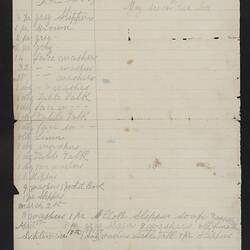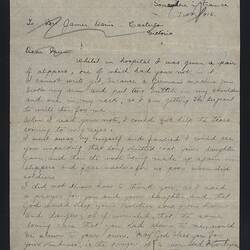Summary
Hand-written letter on stationery from the Australian Branch of the British Red Cross Society, written by Driver E. D. Ross to Mrs J. Davis during World War I.
The letter was written by Driver Edmund Dean Ross. Ross enlisted in 1915 when he was 21 years old and was subsequently sent to France where he was taken on strength by the 22nd Brigade. In January 1917 Ross was diagnosed with shell shock and sent to a hospital in England. It was during his eight-month stay in England that he received a pair of slippers from Mrs Davis through the Red Cross. Ross eventually returned to France before eventually returning to Australia in April, 1919.
Mrs J. Davis is known from other items in the Museum's collection (HT 30545, HT 30546 and HT 30548). One of these items (HT 30545) is a hand-written record Mrs Davis kept of the items she made for soldiers. The other two objects are similar letters of thanks from servicemen. From these letters come her address in Casterton, Victoria and also her husband's name, since one of the letters is addressed to 'Mrs James Davis'. This letter also makes reference to Mrs Davis' sons, who are also serving in the Australian Imperial Forces, as well as a daughter who has helped her to make the items.
The identity of Mrs Davis is suggested from several sources. The 1914 and 1919 census records list four women living in Casterton, Victoria with the surname 'Davis.' Of these women the most likely contender for the Mrs Davis referred to in the letters is 'Kate Davis'. A Catherine Walsted (sometimes referred to in the records as 'Kate') married a James Davis in 1873. The couple had several children including three sons who served in the AIF during World War I and a daughter. Catherine Davis (nee Walsted) died in 1950 and was buried in the Castlemaine Cemetery.
Physical Description
Single sheet of discoloured, stationary that has been folded in two places. The document has a deep vertical crease and the left horizontal crease is also quite deep. The page has the letterhead for the Australian Branch of the British Red Cross Society on the top right side of the page. NB: The page is in landscape orientation.
Significance
The International Committee of the Red Cross was initially established to improve the medical facilities of the army in order to provide better care for wounded soldiers. The Australian Red Cross Society (ARCS) was established in 1914 as a branch of the British Red Cross Society and was active throughout World War I in providing 'comforts' to the troops.
For the most part 'comforts' took the form of homemade articles of clothing donated by thousands of women volunteers; however other items such as food, magazines and other provisions were also distributed by the ARCS. An estimated 395,695 food parcels and 36,339 clothing parcels were sent by the ARCS during World War I.
The items in this small collection relate to the efforts of one woman, Mrs. James Davis, to support the Australian Red Cross and three letters that she received from soldiers who received her items. These letters are significant as they show the gratitude of the soldiers for the 'comforts' that they received from home and their importance. One letter in particular expresses the profound impact such gifts could have upon soldiers since they showed the support and care, not only of their own families, but of the wider Australian community.
The record of Mrs. Davis' creations is impressive in terms of the quantity of items produced by an individual in only a few months. Whilst the list is significant as an example of the dedication of the volunteers who supported the ARCS and how this support became an industry in its own right.
All together this collection of objects provides a rare surviving example of home front activity during World War I.
More Information
-
Collecting Areas
-
Acquisition Information
Transfer from Strategic Collection Management, Collections, Research & Exhibitions, Museum Victoria, 20 Jan 2012
-
Addressed To
-
Author
Driver Edmund D. Ross, Guildford, Surrey, England, Great Britain, 10 Apr 1917
-
Inscriptions
Printed in red ink on the top right portion of the page: 'AUSTRALIAN BRANCH / B.R.C.S.' Hand-written in black ink in the top right portion, below the letter head: 'War Hospital / Wirren Rd. / Guildford / Surrey / England / 10 Ap 1917' Hand-written in black ink as the main body of text: 'Dear Mrs J. Davis / I have much pleasure in / thanking you for your pair of slippers / which I got from the Red Cross...' The letter continues to describe his condition and to further convey his gratitude. The letter ends with the words: 'Yours Respectfully / 7670 E.d. Ross, Driver' Hand-written in black ink on the left side of the page: '7670 Driver E.D. Ross / 20 Battery / 22 Brigade / 2 Division / A.F.A.'
-
Classification
-
Category
-
Discipline
-
Type of item
-
Overall Dimensions
225 mm (Width), 177 mm (Height)
-
Keywords
World War I, 1914-1918, Handcrafts, War Effort, Soldiers' Comforts




